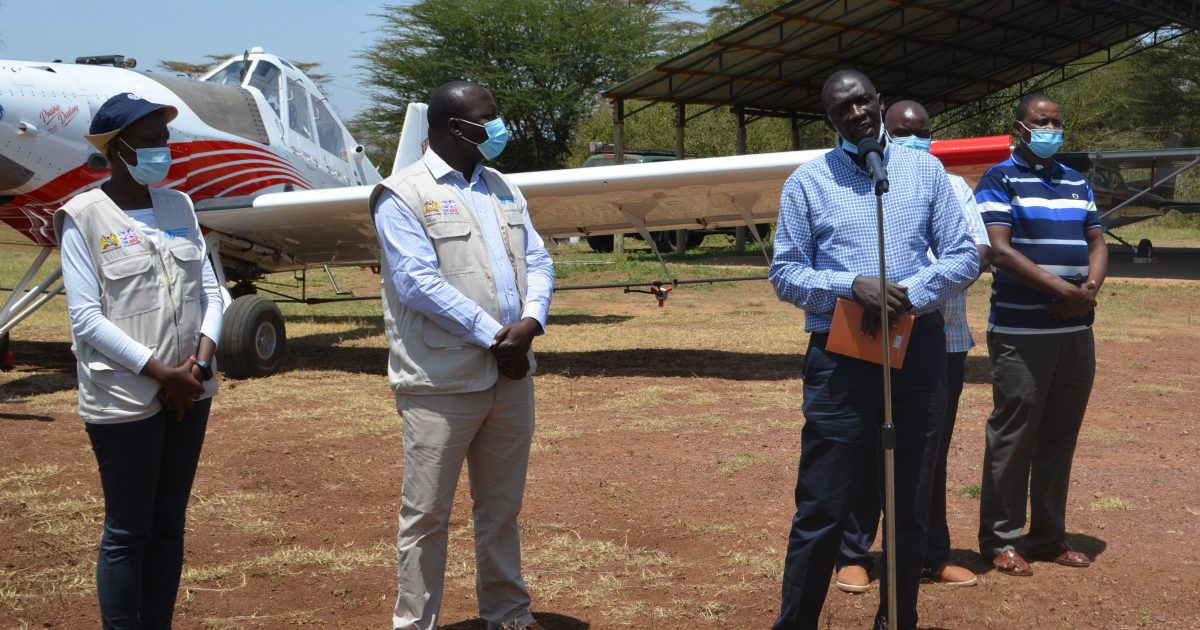The government and the development partners are on the right course in the war against second invasion of desert locusts’ menace.
The government, Food and Agriculture Organization (FAO) and other partners have developed strategies that so far are useful in combating the desert locusts.
The government spokesperson Col. (Rtd) Cyrus Oguna said the second phase of the swarms of locusts that were sighted in the country in November last year have been reduced to between 80 and 85 per cent and expressed optimism that the pests are likely to be eliminated by onset of rains.
He said that concerted effort by all players particularly FAO, World Bank, the affected County governments and other agencies in the country led to the great achievement in the pests’ control.
“We could not have put down these measures of combating the invading locusts without the FAO input and therefore I congratulate them as well as all other partners,” Oguna said during the media briefing on the pests in Isiolo, Wednesday.
Oguna stressed that the government will continue to put in place more strategies to ensure that the locusts do not reproduce more species, adding that enough personnel have been deployed and also logistics employed.
The government together with FAO and other development partners were able to mobilize nine spraying aircrafts where five are used in surveillance and four in spraying.
He added that the lessons the country had learnt from the first phase of invasion helped the country in response to the second infestation in which the combat was prompt and efficient hence the high rate of successful control.
The government spokesperson assured the citizens that there were adequate pesticides revealing that the government had supplied 320,000 litres of pesticides adding that Isiolo County now has 190,000 litres of pesticides which are ready for use.
“This shows that the government is in full control of the menace and was ready for the ongoing campaign and any other unfamiliar invasion. I can as well confirm that the new swarms of the locusts are not matured hence easy to wipe them out,” he added.
He said that locusts control requires regional and cross border collaborative approach so as to avoid the negative impact the menace can cause on the food security and that is why FAO and the neighbouring countries have established control bases all over.
Accordingly, he added that the farmers whose farms have already been sprayed with pesticides have been asked to circumvent the area for three days to prevent health effects.
He called for awareness creation among the residents so that they could know what to expect before, during and after spraying and ensure they are secure in the settlements and in the fields.
A total of 1673 scouts have been trained in the whole country among them National Youth Service (NYS) and the Kenya Wildlife Service (KWS) on what should be done before, during and after the spraying of the pesticides.
And the deputy FAO country director Mr. Hamisi Williams added that the success rate of about 85 per cent was due to preparedness and employment of quick response strategies compared to the last time when the phenomenon was strange.
He said that the Ministry of Agriculture managed to avail 500 National Youth Service (NYS) servicemen who were trained by the FAO to take control on the ground and that has been taken as a key success control of desert locusts in Kenya and also a strong team of 10 Kenya Defense Force soldiers with their five land-cruisers vehicles that were mounted with sprayers.
by David Nduro




